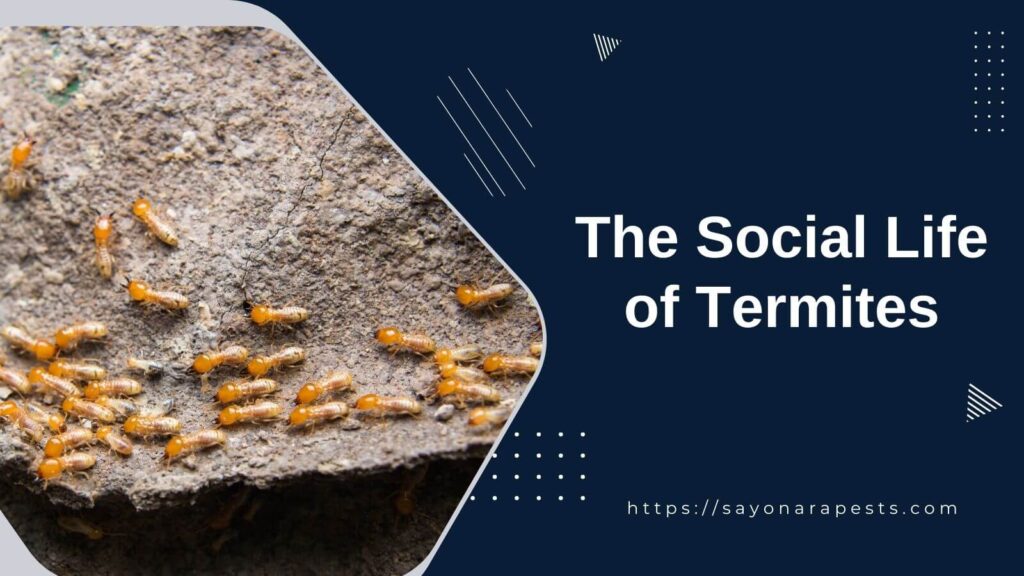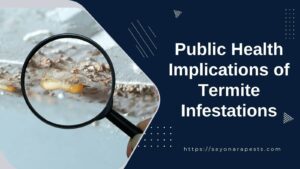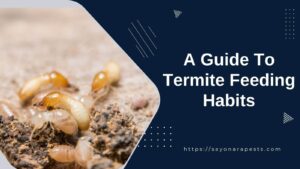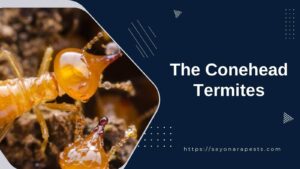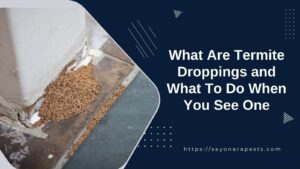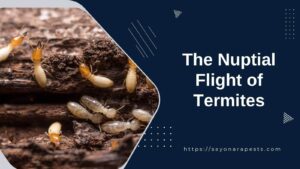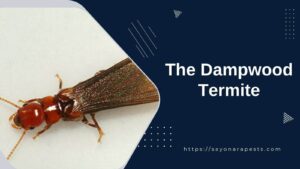Termites, those tiny insects that we often associate with destruction, have a surprisingly intricate and fascinating social life. These little creatures live in complex societies with organized social structures that would put many human organizations to shame.
From their division of labor to their intricate communication methods, termites have captured the attention of scientists and enthusiasts alike.
Understanding the social life of termites is crucial for a variety of reasons. Not only do termites play a crucial role in ecosystems as decomposers and builders, but they also have significant economic impacts.
Termite damage can cost billions of dollars each year, making them a pest that needs to be controlled. In addition, the study of termite societies can offer insights into social behavior, cooperation, and communication, which can be applied to human societies and organizations.
Despite being small and often overlooked, termites have a rich and complex social life that is just waiting to be explored. By delving into the intricacies of their society, we can gain a deeper understanding of the natural world and our place in it.
Termite Societies
Castes and their roles
Termite societies are complex and intricate systems of social organization that have fascinated scientists and laypeople alike. At the heart of termite societies are castes, which are specialized groups of individuals that have evolved to perform specific roles within the colony.
The different castes of termites vary in morphology, behavior, and physiology, and each plays a crucial role in maintaining the colony’s survival and success.
One of the most important castes in termite societies is the reproductive caste. These individuals, also known as alates, are responsible for mating and producing the next generation of termites.
Alates are winged and have specialized adaptations that enable them to fly and seek out mates. Once a suitable mate is found, the pair will shed their wings and establish a new colony. The reproductive caste is essential for the long-term survival of the termite society, as it ensures the production of new workers and soldiers to maintain the colony’s activities.
Another critical caste in termite societies is the worker caste. As the name suggests, workers are responsible for carrying out many of the colony’s essential tasks, including gathering food, building and maintaining the nest, caring for the young, and defending the colony against predators.
Workers are typically blind and wingless, and their bodies are specialized for carrying out these tasks, with strong mandibles for cutting and carrying materials, and a powerful gut for digesting cellulose.
Finally, termite societies also have a soldier caste, which is responsible for defending the colony against predators and other threats. Soldiers are typically larger and more heavily armored than workers, with enlarged mandibles or specialized weapons such as chemical sprays that they use to deter or attack enemies.
The soldier caste is critical for the survival of the colony, as it provides protection against external threats that could otherwise destroy the entire colony.
The castes of termite societies play crucial roles in maintaining the success and survival of these complex social systems. The reproductive caste ensures the production of new individuals, the worker caste carries out essential tasks, and the soldier caste provides protection against predators and other threats.
The specialized adaptations and behaviors of each caste are fascinating and illustrate the incredible complexity and diversity of the natural world. Understanding the workings of termite societies can provide valuable insights into social organization, evolution, and ecology, and can help us appreciate the beauty and wonder of the natural world.
Division of Labor
The division of labor within termite societies is a highly sophisticated process that involves each individual termite assuming a specific role or task. These roles can vary widely depending on the species of termite and the specific needs of the colony, but they typically include tasks such as foraging for food, caring for the young, and maintaining the nest.
In some termite societies, there may even be specialized castes of individuals that are specifically adapted to perform certain tasks.
What is particularly fascinating about the division of labor within termite societies is the way in which it is organized. Unlike human societies, which typically rely on top-down hierarchies to assign roles and tasks, termite societies are self-organizing.
This means that each individual termite is able to determine its own role within the colony based on a complex set of cues and signals that are exchanged between members of the colony.
The result of this self-organizing system is a highly efficient and effective division of labor that allows termite societies to accomplish incredible feats. For example, some species of termites are able to construct massive mounds that can reach heights of up to 30 feet, despite being only a few millimeters in size themselves.
This is only possible because of the highly coordinated efforts of the individual termites within the colony, who work together to build the nest and maintain its structural integrity.
Overall, the division of labor within termite societies is a testament to the incredible abilities of these tiny insects. By working together in a self-organizing system, they are able to accomplish tasks that would be impossible for any individual termite to complete on its own.
As we continue to study and learn more about these fascinating creatures, we can only imagine what other secrets and wonders they may hold.
Communication
When we delve into the world of termite societies, we come across a fascinating realm of communication. These tiny insects, which often go unnoticed by humans, have a highly sophisticated and intricate communication system.
The complexity of their communication system is quite remarkable, as it involves a variety of chemical signals, vibrations, and sounds. These communication methods allow termites to coordinate their activities and work together towards a common goal, such as building their intricate nest structures or foraging for food.
At the heart of termite communication lies the use of pheromones, which are chemical signals that are used to convey information between members of the colony. These pheromones can be used to mark trails, indicate the presence of danger, and even signal to other termites when it is time to start building a new nest.
The use of pheromones is so important in termite societies that some species have evolved to the point where they are almost entirely blind, relying instead on their chemical senses to navigate and communicate with their fellow colony members.
In addition to pheromones, termites also communicate through vibrations and sounds. By tapping on surfaces, termites can communicate with each other over long distances.
These vibrations can also be used to alert colony members to the presence of potential predators, such as ants or birds. In some species, termites also produce audible sounds, which can be used to signal the location of food or to attract mates.
Overall, the communication methods used by termite societies are truly awe-inspiring. Despite their small size, these insects have evolved a highly effective system of communication that allows them to work together in harmony and achieve great things.
From building towering mounds to foraging for food, termites are a testament to the power of cooperation and communication in the animal kingdom.
Termite Social Structure
Colony Organization
The colony structure of termites is characterized by a hierarchical organization, with a division of labor among different castes. These castes are determined by age, morphology, and function within the colony.
The most well-known caste is the reproductive caste, which includes the queen and king termites responsible for producing offspring.
The workers, on the other hand, are responsible for the day-to-day maintenance and upkeep of the colony, such as foraging for food and building and repairing the nest. Finally, the soldier caste serves to defend the colony from outside threats.
The division of labor within a termite colony is so specialized that each caste has evolved to possess unique physical and behavioral adaptations. For example, worker termites have strong jaws and are able to break down tough plant fibers, while soldier termites have large, powerful mandibles for defense.
The queen, meanwhile, is physically specialized for reproduction, with a greatly enlarged abdomen capable of producing thousands of eggs each day.
However, the organization of a termite colony extends beyond just the division of labor among castes. Within each caste, there is also a complex social hierarchy. For example, within the worker caste, there are individuals responsible for different tasks, such as foraging or nest building.
These individuals may occupy different positions within the hierarchy, with some individuals having more authority or control over others.
The level of organization within termite colonies is truly remarkable, and researchers continue to study the intricate details of termite social structure. By understanding the organization and behavior of these tiny insects, we can gain insights into the evolution of social behavior and the role it plays in the natural world.
Reproductive System
The reproductive system of termites is highly specialized and differs significantly from that of other insects. Termite colonies are typically divided into two distinct groups – reproductives and non-reproductives.
Reproductives are further divided into kings and queens, which are responsible for the production of offspring and the expansion of the colony.
Termite queens are some of the most remarkable creatures in the animal kingdom. They can live for decades and lay thousands of eggs each day, ensuring the survival and growth of the colony.
Kings, on the other hand, are responsible for fertilizing the queen’s eggs and maintaining the genetic diversity of the colony.
The reproductive system of termites is also characterized by a high degree of plasticity and flexibility.
In some species, workers and soldiers can become reproductive individuals under certain circumstances, allowing the colony to adapt to changing environmental conditions and increase its chances of survival.
However, the reproductive system of termites is not without its challenges. Inbreeding, for example, can be a significant problem for colonies with limited genetic diversity, leading to reduced fitness and increased susceptibility to disease and predation.
Overall, the reproductive system of termites is a fascinating subject that highlights the incredible adaptability and resilience of these complex social insects.
Whether in the form of queens, kings, or even worker and soldier reproductives, this system is essential for the survival and success of termite colonies in a constantly changing world.
Nest Construction
Termites have evolved an elaborate system of nest building that involves the coordination of thousands of individual workers.
The process of constructing a nest is an incredibly complex and dynamic process that requires a high degree of cooperation and communication among the workers.
Termites build their nests from a combination of mud, soil, and saliva. The nest is designed to provide protection from predators and the elements, as well as to regulate temperature and humidity levels.
The construction of the nest is a continuous process that involves the addition of new material and the repair of damaged areas. This process can continue for decades or even centuries, depending on the size and complexity of the colony.
The construction of a termite nest is a highly organized process. Workers are responsible for gathering materials and transporting them to the building site. They also manipulate the materials to create the desired shape and structure of the nest.
Soldiers play a role in defending the nest from predators and other threats. The queen, who is the reproductive center of the colony, is responsible for laying eggs and maintaining the population of the colony.
The coordination and communication required for termite nest construction are truly remarkable. Workers use chemical signals to communicate with each other, allowing them to coordinate their efforts and work together to build the nest.
This chemical communication system is so advanced that it allows workers to differentiate between different types of building materials and respond appropriately to changing environmental conditions.
The construction of a termite nest is an incredible feat of organization and communication. The coordination required to build and maintain a complex structure over an extended period of time is truly remarkable.
The study of termite social structure and nest construction provides valuable insights into the evolution of social behavior and the role of communication in the animal kingdom.
Termite Behavior
Foraging
Termites are social insects that exhibit a wide range of behaviors, with foraging being a particularly important one. Foraging is the process by which termites search for food sources and bring them back to the nest to share with the rest of the colony.
This behavior is critical for the survival of the termite colony as it provides the necessary nutrients for growth and reproduction. However, the foraging behavior of termites is complex and multifaceted, with many factors influencing when and how termites forage.
One of the key factors that influence termite foraging behavior is the availability of food. Termites are highly attuned to changes in their environment and can quickly detect the presence of food sources.
Once a food source is detected, termites will swarm the area and begin to feed. However, they are also highly sensitive to changes in the quality of the food source and will adjust their foraging behavior accordingly.
For example, if a food source becomes contaminated or depleted, termites will quickly abandon it and search for a new one.
Another important factor that influences termite foraging behavior is the time of day. Termites are known to be more active during certain times of the day, with peak foraging activity typically occurring at night.
This is likely due to the fact that termites are sensitive to light and prefer to forage in the dark when they are less likely to be detected by predators.
In addition to environmental factors, termite foraging behavior is also influenced by social cues. Termites are highly social insects that rely on chemical signals to communicate with one another.
When a termite finds a food source, it will leave a trail of pheromones behind it to guide other termites to the location. This chemical signaling system allows termites to quickly and efficiently communicate with one another and is critical for the success of the colony.
Overall, the foraging behavior of termites is a complex and multifaceted process that is influenced by a wide range of factors. From environmental cues such as food availability and time of day to social cues such as chemical signaling, termites are highly attuned to their surroundings and able to adapt their behavior accordingly.
Understanding the intricacies of termite foraging behavior is critical for developing effective pest control strategies, as well as for gaining a deeper appreciation for these fascinating and highly social insects.
Mating Behavior
The intricate mating behavior of termites has fascinated scientists and researchers for decades, with its complexity and mysterious nature posing a significant challenge to understanding. The process of finding a mate in termites involves a combination of chemical, auditory, and visual cues, making it a highly coordinated and sophisticated process that is not yet fully comprehended.
Chemical signals are the primary means by which termites communicate with one another during mating, with males and females releasing specific pheromones to attract potential partners. The specific chemicals released vary between species, and the timing of their release is also critical, as it can influence the response of potential mates.
Auditory signals also play a crucial role in the mating behavior of termites, with males producing distinct sounds that serve to attract females. These sounds are generated by stridulation, a process that involves rubbing body parts together to create vibrations that produce distinctive noise.
Interestingly, different species of termites produce different sounds, with some producing a high-pitched noise while others produce a more low-frequency sound.
This variability in sound production is thought to reflect differences in the frequency range of the mating signals, as well as the size and shape of the male’s body parts involved in stridulation.
Visual cues are also important in termite mating behavior, with males and females engaging in a range of visual displays to attract potential partners. These displays can include wing-flapping, head-bobbing, and antennae-waving, all of which serve to communicate the readiness of the individual to mate.
Interestingly, some species of termites engage in a behavior known as “soldiering,” where non-reproductive individuals protect the reproductive individuals and perform displays to ward off potential competitors.
Overall, the complex mating behavior of termites is a fascinating and highly dynamic process that continues to intrigue researchers in the field of animal behavior.
Despite significant progress in understanding the chemical, auditory, and visual cues involved, there is still much to be learned about the intricacies of termite mating behavior and the factors that influence it.
As such, ongoing research into this topic is critical to gain a more comprehensive understanding of this fascinating and enigmatic behavior.
Defense Mechanism
Termites are fascinating insects that exhibit a complex array of behaviors, including their remarkable defense mechanism. These small creatures have developed sophisticated ways to protect their colonies against potential threats, such as predators and other invading insects.
The defense mechanism of termites is a highly coordinated response that involves different members of the colony working together to ward off any danger.
One of the most impressive aspects of termite defense is its ability to produce and release defensive chemicals. When a termite colony is under attack, some members of the colony, called soldiers, will emit a chemical signal to alert the others.
This signal triggers the release of a sticky, glue-like substance called “terpene” that is secreted from specialized glands in the soldiers’ bodies. This substance can effectively trap and immobilize predators or other invaders, preventing them from causing harm to the colony.
In addition to their chemical defense mechanism, termites also use physical means to protect themselves. Soldiers have specialized mandibles that they use to attack and bite predators, such as ants or other termite species that try to invade their territory.
These mandibles are large and powerful, and can easily crush an invader or tear apart any material that poses a threat to the colony.
Overall, termite behavior is a fascinating and complex subject, and its defense mechanism is just one example of the impressive abilities of these insects. The coordinated response and sophisticated communication that takes place within the colony are truly remarkable and serve as a testament to the power of collective action in nature.
Understanding termite behavior can also have important practical applications, such as developing effective strategies for pest control or learning more about the ecological roles of these insects in their natural habitats.
Ecological Importance of Termites
Ecosystem Engineers
When it comes to the ecological importance of termites, there is no denying that they play a crucial role in shaping the environment around them. As ecosystem engineers, termites are responsible for modifying their surroundings in a number of ways, often leading to dramatic changes in the local ecosystem.
From building elaborate nests that alter the physical structure of the landscape to breaking down tough plant material and recycling nutrients, termites have a profound impact on the world we live in.
Perhaps one of the most fascinating aspects of termite ecology is the way in which these insects alter the soil around them. Through their foraging and nest-building activities, termites create a network of underground tunnels and galleries that can extend for many meters in all directions.
These tunnels help to aerate the soil and promote the growth of beneficial microorganisms, while also facilitating the movement of water and nutrients through the soil profile. As a result, areas inhabited by termites are often more fertile and productive than adjacent areas, providing important ecological services to plants and animals alike.
But the ecological importance of termites goes far beyond their effects on the soil. These insects are also important decomposers, breaking down tough plant material and recycling nutrients back into the ecosystem.
In fact, termites are one of the few insects capable of breaking down lignin, a complex polymer found in the cell walls of woody plants. By breaking down this tough material, termites help to release carbon and other nutrients back into the soil, where they can be taken up by other organisms.
Nutrient Cycling
Termites, the often-overlooked insects, play a crucial role in the ecological balance of our planet. These tiny creatures are renowned for their impressive ability to break down wood and other plant materials, returning vital nutrients back to the soil.
This process is known as nutrient cycling and is crucial for the survival of many plant and animal species. Nutrient cycling is the process by which nutrients, such as nitrogen and phosphorus, are taken up by plants, then eaten by animals, and eventually returned to the soil where they can be used again.
Termites play a significant role in this process, as they are one of the most important decomposers in many ecosystems.
Termites are able to break down the complex cellulose found in wood and other plant materials, releasing nutrients that can be taken up by other organisms. Without termites, much of this material would remain in its complex form, making it difficult for other organisms to access the nutrients they need.
In many ecosystems, termites are the primary decomposers of wood, which makes them essential to nutrient cycling. They play a crucial role in ensuring that nutrients are continuously recycled through the ecosystem, allowing plants and other organisms to thrive.
Furthermore, termites are known to be a significant source of nitrogen in many ecosystems. They have symbiotic relationships with bacteria in their gut that are capable of fixing nitrogen, making it available for plants to use.
This nitrogen fixation is crucial for the growth and survival of many plant species, especially those that live in nutrient-poor environments. Termites also help to break down organic matter in the soil, making nutrients more available to plants. By breaking down organic matter and returning it to the soil, termites help to improve soil fertility and increase the productivity of many ecosystems.
The ecological importance of termites, particularly in nutrient cycling, cannot be overstated. These tiny creatures play a vital role in breaking down complex plant materials, releasing nutrients back into the soil, and ensuring the survival of many plant and animal species.
As we continue to explore and study the natural world, it is important to remember the crucial role that termites play in maintaining the delicate balance of our planet’s ecosystems.
Influence on Plant Growth
The ecological importance of termites cannot be overstated, particularly when it comes to their influence on plant growth. Termites play a significant role in the maintenance of soil quality, which in turn directly affects the ability of plants to grow and thrive.
Termites also have an indirect influence on plant growth through their interactions with other organisms. For example, termites often form mutualistic relationships with fungi, which can help to break down organic matter and make nutrients more available to plants.
In some cases, termites may also serve as a food source for other animals, such as birds or mammals, which can in turn impact the distribution and abundance of plants in a given ecosystem.
Overall, the influence of termites on plant growth is complex and multifaceted, and further research is needed to fully understand the extent of their ecological importance.
However, it is clear that these tiny insects play a critical role in the functioning of many ecosystems around the world, and their presence or absence can have significant consequences for the health and vitality of plant communities.
Evolution of Termite Societies
Historical Development of Societies
The historical development of termite societies is a complex and fascinating subject that has captivated scientists for decades.
Termites are social insects that have evolved over millions of years to live in highly structured colonies with specialized roles for each individual member.
The origins of termite societies can be traced back to the Early Cretaceous period, over 130 million years ago, when the first termite-like insects appeared in the fossil record.
Over time, termite societies evolved to become more complex and sophisticated, with distinct castes of individuals that perform specialized tasks.
The division of labor within a termite colony is highly organized, with workers responsible for tasks such as foraging, nest building, and caring for the young, while soldiers defend the colony from predators and other threats.
Reproductive individuals, such as queens and kings, are responsible for producing new offspring and ensuring the survival of the colony.
One of the most fascinating aspects of termite societies is their ability to build elaborate structures without any central control or direction. Termites use a process called stigmergy to coordinate their behavior and communicate with each other.
This process involves leaving chemical signals or pheromones that guide other members of the colony to perform specific tasks. As a result, even though individual termites have limited cognitive abilities, the collective behavior of the colony can be brilliant and sophisticated.
Despite their impressive abilities, termite societies are not static and unchanging. Over time, they can adapt to changing environmental conditions and evolve new behaviors and structures.
For example, some termite species have evolved to build complex above-ground nests, while others live in subterranean tunnels. In some cases, termites have even developed symbiotic relationships with other organisms, such as fungi or bacteria, that help them to break down and digest cellulose.
Overall, the evolution of termite societies is a complex and dynamic process that is still not fully understood. By studying these fascinating insects, scientists hope to gain new insights into the origins of social behavior and the mechanisms that drive the evolution of complex systems.
Comparative Analysis of Termite Social Structures
Through comparative analysis of termite social structures, scientists have been able to uncover some of the fascinating evolutionary pathways that have led to their success.
One of the most striking features of termite societies is the division of labor among the different members. Each termite has a specific role to play, and they work together to ensure the survival of the colony as a whole.
This kind of organization is something that is typically only seen in much larger animals, and it’s fascinating to see it play out on such a small scale.
The evolution of these social structures is not well understood, and there are many different theories as to how they came about. Some researchers believe that the division of labor evolved as a way to maximize efficiency, while others think that it was a response to the challenges of living in large groups.
Regardless of the exact mechanism, there is no denying the impressive nature of termite societies. Through their complex social structures, they have managed to thrive in a wide range of environments, from the rainforests of South America to the deserts of Africa.
Overall, these tiny insects have managed to form complex societies that rival those of much larger animals, and studying them can provide valuable insights into the nature of social organization and evolution as a whole.
Role of Environmental Factors in the Evolution of Termite Societies
The environmental factors that have influenced the evolution of termite societies are many and varied. For example, the availability of food resources is a critical factor that has driven the development of social structures in termites.
In environments where food resources are scarce, termites have evolved sophisticated foraging strategies and communication systems that allow them to efficiently locate and exploit food sources.
In contrast, in environments with abundant food resources, termites may adopt a more relaxed and less hierarchical social structure, with less emphasis on specialization and division of labor.
In addition to food resources, other environmental factors that have contributed to the evolution of termite societies include temperature, humidity, and predation pressure.
Termites are highly sensitive to changes in temperature and humidity and have developed intricate mechanisms for regulating their internal environment to maintain optimal conditions for colony growth and survival.
Moreover, the threat of predation has driven the evolution of complex defensive mechanisms in termites, such as the construction of elaborate nests and the production of defensive chemicals.
Despite the importance of environmental factors in shaping termite societies, it is important to note that genetic and developmental factors also play a significant role in determining the characteristics and behaviors of individual termites.
Indeed, the interplay between genetic and environmental factors is a complex and dynamic process that continues to be the subject of intense study and debate among researchers in the field.
Overall, the evolution of termite societies is a complex and multifaceted process that is shaped by a wide range of environmental factors. From food resources to temperature and humidity to predation pressure, the natural environment has played a critical role in the development and organization of these remarkable insect societies.
Social Parasitism in Termites
Social Parasites
Social parasitism in termites refers to a unique phenomenon where certain termite species exploit the social behavior of other termite species to survive and propagate.
Social parasites are essentially organisms that depend on the work of other individuals or groups without offering any significant benefits in return.
In the case of termites, social parasites rely on the resources and labor of the host colony, manipulating their behavior to meet their own needs. There are different types of social parasites in termites, including inquilines, interspecific nestmates, and termitophiles.
Inquilines are social parasites that live within the nest of the host colony without contributing to the labor force or defense mechanisms. Instead, they rely on the host colony to provide them with food, shelter, and protection.
Interspecific nestmates, on the other hand, are social parasites that invade the nest of the host colony, take over the queen, and force the workers to raise their brood. In this way, the interspecific nestmate benefits from the resources of the host colony without contributing to the labor force.
Lastly, termitophiles are social parasites that live on the surface of the host colony and feed on the termites’ excrement or dead bodies. While they do not directly harm the host colony, termitophiles benefit from their resources without offering any significant benefits in return.
The concept of social parasitism in termites is fascinating and complex, involving a complex interplay of biological and ecological factors. Social parasites have evolved unique adaptations that allow them to exploit the social behavior of the host colony, such as specialized chemical signals or morphological adaptations.
Additionally, social parasitism in termites has significant implications for the evolution of social behavior and cooperation in insects. By studying social parasitism in termites, scientists can gain valuable insights into the evolution of social behavior, cooperation, and parasitism in other species.
Ultimately, social parasitism in termites highlights the remarkable complexity and diversity of life on earth and the ongoing struggle for survival and adaptation in the face of changing environmental conditions.
Host-Parasite Interactions
When examining the topic of social parasitism in termites, one must first delve into the complex web of host-parasite interactions that occur within the colonies. Social parasitism refers to the phenomenon in which one species exploits the social behavior of another species for its own benefit.
In the case of termites, social parasites take advantage of the social structures and resources provided by their host colonies. This can include stealing food, usurping breeding rights, and even manipulating the behavior of their hosts to better suit their own needs.
The interactions between hosts and parasites are not one-sided, however. Hosts have developed a range of defense mechanisms to combat the threat of parasitism, from physical barriers to behavioral adaptations.
These adaptations can include increased aggression towards potential invaders, the development of specialized soldier castes to defend the colony, and even the production of toxic secretions to deter parasites.
The arms race between hosts and parasites is ongoing, with each side constantly evolving to outsmart the other.
Despite the elaborate defenses of host colonies, social parasites have managed to thrive and persist through their ability to adapt to the changing conditions of their environment.
This adaptability is reflected in the wide variety of social parasites found in termite colonies, from those that infiltrate and take over the entire colony to those that live alongside their hosts, using them as a source of food and shelter.
The evolution of social parasitism in termites is a complex and ongoing process that has played a significant role in shaping the behavior and ecology of both hosts and parasites.
The study of social parasitism in termites has far-reaching implications beyond the realm of entomology. Understanding the mechanisms and dynamics of host-parasite interactions can provide insight into the broader ecological and evolutionary processes that govern the interactions between species.
It can also inform the development of strategies for controlling and managing pest species, both in natural and agricultural settings.
As our understanding of social parasitism in termites continues to grow, so too does our appreciation for the complexity and diversity of the natural world.
Impact of Social Parasitism on Termite Societies
In a termite society, social parasitism refers to a situation where a group of termites, known as social parasites, exploit the labor and resources of the host colony without contributing anything in return.
This form of parasitism has a significant impact on termite societies and can cause severe disruption and instability. The social parasites have evolved specialized traits and behaviors that allow them to infiltrate and exploit the host colony successfully.
The impact of social parasitism on termite societies is complex and multifaceted. One of the most apparent effects is the significant reduction in the reproductive potential of the host colony.
Social parasites often monopolize the reproductive opportunities in the colony, which leads to a decrease in the number of eggs produced by the host queen. This reduction in reproductive output can have a cascading effect on the colony’s survival and ultimately lead to its collapse.
Social parasitism also affects the division of labor within the host colony. Termites have a highly organized division of labor that ensures the efficient functioning of the colony. However, social parasites disrupt this division of labor by manipulating the behavior of the host workers.
They use pheromones and other chemical cues to trick the host workers into providing them with food and other resources. This disruption can lead to a breakdown in the social organization of the colony, making it vulnerable to other threats.
Another significant impact of social parasitism is the spread of disease and pathogens. Social parasites often carry diseases and pathogens that can be transmitted to the host colony, leading to increased mortality rates.
This increased mortality can have a significant impact on the long-term survival of the colony, particularly if the host colony is already weakened by other factors.
Future Research on Termite Societies
Termite societies are incredibly complex and fascinating systems that have been studied extensively in the field of entomology. Current research on termite societies has uncovered a wealth of information about their behavior, communication, and social structure.
Scientists have used a variety of tools and techniques, including genetics, neurobiology, and ethology, to gain a deeper understanding of these organisms and their societies.
They have studied the chemical signals that termites use to communicate with each other, the social organization of termite colonies, and the ecological and evolutionary factors that shape termite behavior.
Despite the significant progress made in understanding termite societies, many areas remain for future investigation. One key area of interest is the role of epigenetic mechanisms in termite behavior and social organization.
Epigenetics refers to changes in gene expression that are not due to changes in DNA sequence. Recent studies have suggested that epigenetic mechanisms may play a significant role in shaping termite societies, and researchers are keen to explore this further.
Another area for future investigation is the impact of environmental factors, such as temperature and humidity, on termite behavior.
Termites are highly sensitive to changes in their environment, and researchers are interested in understanding how they respond to different conditions. This research could have important implications for pest control strategies, as well as for understanding the potential impact of climate change on termite populations.
In addition to the scientific interest in understanding termite societies, there are also potential applications of this research. For example, understanding the chemical signals that termites use to communicate could lead to the development of more effective pest control methods.
Similarly, understanding the social organization of termite colonies could inform the development of more efficient and sustainable farming practices, such as the use of termites for soil cultivation.
Overall, the study of termite societies is a rich and complex field that holds great promise for both basic scientific understanding and practical applications.
As researchers continue to explore the many facets of termite behavior and social organization, they are likely to uncover new insights into these fascinating organisms and the systems they create.
Termites are known for their highly complex and fascinating societies. The social life of these insects is an essential aspect of understanding their behavior, which is crucial for their ecological importance and potential applications.
The social structure of termites is defined by the caste system, which involves specific roles that each caste plays in the colony’s organization. These roles are crucial to ensure the smooth running of the colony and the division of labor.
The communication system of termites is another intriguing aspect of their social life. Termites use chemical signals to communicate with one another, and this communication system plays a vital role in the organization of the colony. Nest construction is also a critical aspect of the termite social structure. These insects build elaborate nests, which are designed to house the colony and protect it from predators.
Termites have fascinating behaviors that have been studied for years. Foraging is a critical aspect of their behavior, and the intricate paths they take to find food sources have been a topic of research for many years.
Mating behavior is another crucial aspect of termite behavior. Termites have a specific reproductive system that involves swarming, which is the dispersal of the reproductive caste. Defense mechanisms are also a critical aspect of termite behavior, as they need to protect themselves and their colony from potential threats.
Termites are essential for nutrient cycling and are considered ecosystem engineers. Their impact on plant growth has also been studied extensively, and they are known to play a vital role in maintaining a healthy ecosystem.
The evolution of termite societies is a topic that has been studied for many years. The historical development of termite societies and the role of environmental factors in their evolution have been a topic of research for many years.
Social parasitism in termites is another intriguing aspect of their social life. Social parasites are a type of termite that relies on another termite colony to survive.
The impact of social parasitism on termite societies has been studied extensively, and the host-parasite interactions have been a topic of research for many years.
Future research on termite societies is essential to understand these insects fully. Current research and areas for future investigation are crucial to the development of potential applications of research.
The potential applications of research on termite societies include their use as biofuels, their role in sustainable agriculture, and potential medical applications.
In conclusion, the social life of termites is a fascinating subject that has been studied for many years. The termite’s social structure, behavior, ecological importance, evolution, and social parasitism are all critical aspects of their social life.
Continued research on termite societies is essential for the development of potential applications of research and to understand the ecological importance of these insects fully. The social life of termites is a fascinating subject that will continue to be studied for many years to come.

